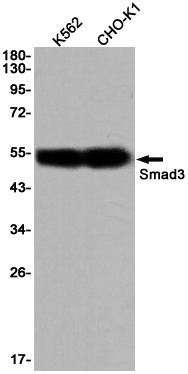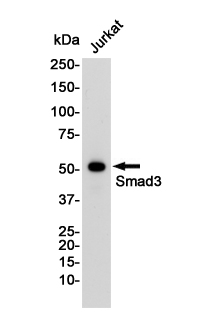-
Product Name
Anti-Smad3 Rabbit antibody
- Documents
-
Description
Smad3 Rabbit polyclonal antibody
-
Tested applications
WB, IP
-
Species reactivity
Human, Mouse, Rat
-
Alternative names
LDS3; LDS1C; MADH3; JV15-2; HSPC193; HsT17436 antibody
-
Isotype
Rabbit IgG
-
Preparation
Antigen: Recombinant protein of human Smad3
-
Clonality
Polyclonal
-
Formulation
Supplied in 50nM Tris-Glycine(pH 7.4), 0.15M Nacl, 40%Glycerol, 0.01% sodium azide and 0.05% BSA.
-
Storage instructions
Store at -20°C. Stable for 12 months from date of receipt.
-
Applications
WB: 1/1000
IP: 1/20
-
Validations

Western blot detection of Smad3 in K562,CHO-K1 cell lysates using Smad3 Rabbit pAb(1:1000 diluted).Predicted band size:48KDa.Observed band size:52KDa.

Western blot detection of Smad3 in Jurkat cell lysates using Smad3 Rabbit pAb(1:1000 diluted).Predicted band size:48KDa.Observed band size:52KDa.
-
Background
Swiss-Prot Acc.P84022.Receptor-regulated SMAD (R-SMAD) that is an intracellular signal transducer and transcriptional modulator activated by TGF-beta (transforming growth factor) and activin type 1 receptor kinases. Binds the TRE element in the promoter region of many genes that are regulated by TGF-beta and, on formation of the SMAD3/SMAD4 complex, activates transcription. Also can form a SMAD3/SMAD4/JUN/FOS complex at the AP-1/SMAD site to regulate TGF-beta-mediated transcription. Has an inhibitory effect on wound healing probably by modulating both growth and migration of primary keratinocytes and by altering the TGF-mediated chemotaxis of monocytes. This effect on wound healing appears to be hormone-sensitive. Regulator of chondrogenesis and osteogenesis and inhibits early healing of bone fractures. Positively regulates PDPK1 kinase activity by stimulating its dissociation from the 14-3-3 protein YWHAQ which acts as a negative regulator.
Related Products / Services
Please note: All products are "FOR RESEARCH USE ONLY AND ARE NOT INTENDED FOR DIAGNOSTIC OR THERAPEUTIC USE"
